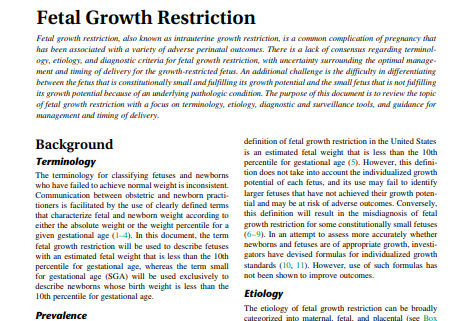Fetal Growth Restriction
Fetal growth restriction, also known as intrauterine growth restriction, is a common complication of pregnancy that has been associated with a variety of adverse perinatal outcomes. There is a lack of consensus regarding terminology, etiology, and diagnostic criteria for fetal growth restriction, with uncertainty surrounding the optimal management and timing of delivery for the growth-restricted fetus. An additional challenge is the difficulty in differentiating between the fetus that is constitutionally small and fulfilling its growth potential and the small fetus that is not fulfilling its growth potential because of an underlying pathologic condition. The purpose of this document is to review the topic of fetal growth restriction with a focus on terminology, etiology, diagnostic and surveillance tools, and guidance for management and timing of delivery.
Background Terminology
The terminology for classifying fetuses and newborns who have failed to achieve normal weight is inconsistent. Communication between obstetric and newborn practitioners is facilitated by the use of clearly defined terms that characterize fetal and newborn weight according to either the absolute weight or the weight percentile for a given gestational age (1–4). In this document, the term fetal growth restriction will be used to describe fetuses with an estimated fetal weight that is less than the 10th percentile for gestational age, whereas the term small for gestational age (SGA) will be used exclusively to describe newborns whose birth weight is less than the 10th percentile for gestational age.
Prevalence
The prevalence of fetal growth restriction depends on the definition used. As noted previously, the most widely used definition of fetal growth restriction in the United States is an estimated fetal weight that is less than the 10th percentile for gestational age (5). However, this definition does not take into account the individualized growth potential of each fetus, and its use may fail to identify larger fetuses that have not achieved their growth potential and may be at risk of adverse outcomes. Conversely, this definition will result in the misdiagnosis of fetal growth restriction for some constitutionally small fetuses (6–9). In an attempt to assess more accurately whether newborns and fetuses are of appropriate growth, investigators have devised formulas for individualized growth standards (10, 11). However, use of such formulas has not been shown to improve outcomes.


